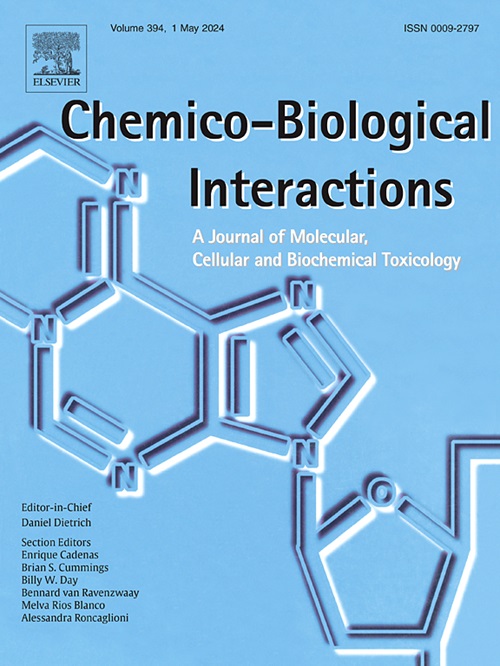Exposure of human neuroblastoma SH-SY5Y cells to amphetamine-type stimulants leads to oxidative-antioxidative imbalance associated with DNA damage and acetylcholine antagonism
IF 4.7
2区 医学
Q1 BIOCHEMISTRY & MOLECULAR BIOLOGY
引用次数: 0
Abstract
Amphetamine-type stimulants (ATSs) are widely abused substances that impair central and peripheral nervous system functions. The mechanisms of their toxicity on human neuronal cells have not been fully clarified yet but include effects on oxidative-antioxidative balance and interaction with synaptic enzymes/receptors. The aims of this study were to determine oxidant/antioxidant status, DNA integrity and the activity of neurotransmitter system components (monoamine oxidase A, MAO-A and nicotinic acetylcholine receptors, nAChR) in human neuroblastoma SH-SY5Y cells after 24-h exposure to different ATSs. In this matter, we first evaluated cell viability by MTS assay. After determination of the concentrations (near IC25) suitable for conduction of the alkaline comet assay, these were further studied for the extent of DNA damage, along with the levels of malondialdehyde, reactive oxygen species (ROS), glutathione (GSH) and activities of antioxidative enzymes superoxide dismutase (SOD), glutathione peroxidase (GPx) and catalase (CAT). The activity of the MAO-A enzyme and nAChR activity were evaluated at concentration range 1–50 μM. Finally, the in silico pharmacokinetic parameters predictions of the tested ATSs were determined. When compared to untreated cells, the most notable result was obtained for amphetamine (AMP), where we observed a significant increase in ROS levels, SOD, GPx and CAT activity, and a decrease in GSH levels. Interestingly, all of the tested ATSs increased the activity of GPx, while the activities of the other enzymes were compound-dependent. The new psychoactive substance (NPS) mephedrone (4-MMC) had a similar effect as AMP, except that it did not affect CAT activity. At the tested concentrations, AMP, methamphetamine (METH) and 4-MMC also showed effects on DNA stability. None of the tested ATSs inhibited MAO-A in the tested concentration range, but AMP, METH, 3,4-methylenedioxymethamphetamine (MDMA) and 3,4-methylenedioxyamphetamine (MDA) inhibited acetylcholine activation of human nAChR. Taken together, significant induction of oxidative stress parameters, increased level of DNA damage detected and inhibition of nAChR activity indicate potential mechanisms of ATS substances action, and represent the direction for further studies to clarify the toxicological risks associated with ATS and/or NPS consumption.
人神经母细胞瘤SH-SY5Y细胞暴露于苯丙胺类兴奋剂导致与DNA损伤和乙酰胆碱拮抗相关的氧化-抗氧化失衡
安非他明类兴奋剂(ats)是一种广泛滥用的损害中枢和周围神经系统功能的物质。它们对人类神经细胞的毒性机制尚未完全阐明,但包括对氧化-抗氧化平衡的影响以及与突触酶/受体的相互作用。本研究的目的是测定不同ATSs暴露24小时后人神经母细胞瘤SH-SY5Y细胞的氧化/抗氧化状态、DNA完整性和神经递质系统组分(单胺氧化酶A、MAO-A和烟碱乙酰胆碱受体nAChR)的活性。在这个问题上,我们首先用MTS法评估细胞活力。在确定适合碱性彗星试验的浓度(接近IC25)后,进一步研究DNA损伤程度、丙二醛、活性氧(ROS)、谷胱甘肽(GSH)水平以及抗氧化酶超氧化物歧化酶(SOD)、谷胱甘肽过氧化物酶(GPx)和过氧化氢酶(CAT)的活性。在1 ~ 50 μM浓度范围内测定MAO-A酶活性和nAChR活性。最后,确定了所测ats的计算机药代动力学参数预测。与未处理的细胞相比,最显著的结果是安非他明(AMP),我们观察到ROS水平、SOD、GPx和CAT活性显著增加,GSH水平下降。有趣的是,所有测试的ats都增加了GPx的活性,而其他酶的活性则依赖于化合物。新型精神活性物质(NPS)甲氧麻黄酮(4-MMC)除不影响CAT活性外,其作用与AMP相似。在测试浓度下,AMP、甲基苯丙胺和4-MMC也对DNA稳定性有影响。在测试浓度范围内,所有ats均未抑制MAO-A,但AMP、甲基安非他明、3,4-亚甲基二氧基苯丙胺(MDMA)和3,4-亚甲基二氧基苯丙胺(MDA)抑制乙酰胆碱对人nAChR的激活。综上所述,氧化应激参数的显著诱导、检测到的DNA损伤水平的增加以及nAChR活性的抑制表明了ATS物质作用的潜在机制,并代表了进一步研究的方向,以阐明ATS和/或NPS消费相关的毒理学风险。
本文章由计算机程序翻译,如有差异,请以英文原文为准。
求助全文
约1分钟内获得全文
求助全文
来源期刊
CiteScore
7.70
自引率
3.90%
发文量
410
审稿时长
36 days
期刊介绍:
Chemico-Biological Interactions publishes research reports and review articles that examine the molecular, cellular, and/or biochemical basis of toxicologically relevant outcomes. Special emphasis is placed on toxicological mechanisms associated with interactions between chemicals and biological systems. Outcomes may include all traditional endpoints caused by synthetic or naturally occurring chemicals, both in vivo and in vitro. Endpoints of interest include, but are not limited to carcinogenesis, mutagenesis, respiratory toxicology, neurotoxicology, reproductive and developmental toxicology, and immunotoxicology.

 求助内容:
求助内容: 应助结果提醒方式:
应助结果提醒方式:


